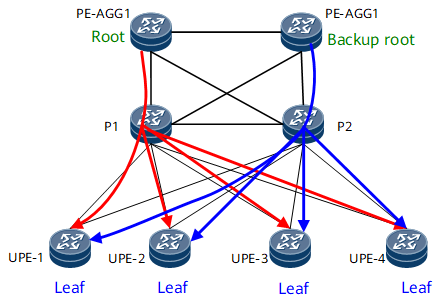BFD for P2MP Tunnel
BFD for P2MP tunnel applies when the primary and backup mLDP P2MP tresses are established on roots on NG-MVPN or VPLS networks. With this function, a BFD session is established to monitor the connectivity of the primary mLDP P2MP tree. If the BFD session detects a fault, it rapidly switches traffic to the backup tree, which minimizes traffic loss.
Benefits
No tunnel protection is provided in the NG-MVPN over mLDP P2MP function or VPLS over mLDP P2MP function. If an LSP fails, traffic can only be switched using route change-induced hard convergence, which renders low performance. BFD for P2MP tunnel provides a dual-root mLDP 1+1 protection mechanism for the NG-MVPN over mLDP P2MP function or VPLS over mLDP P2MP function. The primary and backup tunnels are established for VPN traffic. If a P2MP tunnel fails, BFD For mLDP P2MP tunnel rapidly detects the fault and switches traffic, which improves convergence performance for the NG-MVPN over mLDP P2MP function or VPLS over mLDP P2MP function and minimizes traffic loss.
Principles
In Figure 1, a root uses BFD to send protocol packets to all leaf nodes along a P2MP LDP LSP. If a leaf node fails to receive BFD packets within a specified period, a fault occurs.
In an NG-MVPN or VPLS scenario shown in Figure 1, each of two roots establishes an mLDP P2MP tree. PE-AGG1 is the master root, and PE-AGG2 is the backup root. The two trees do not overlap. BFD for P2MP tunnel is configured on the roots and leaf nodes to establish BFD sessions. If a BFD session detects a fault in the primary P2MP tunnel, a forwarder rapidly detects the fault and switches NG-MVPN or VPLS traffic to the backup P2MP tunnel.
